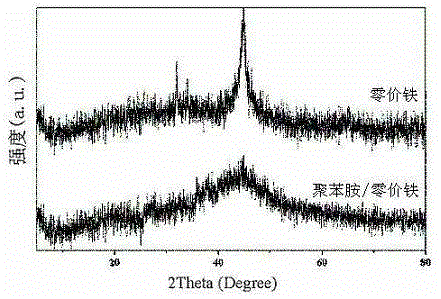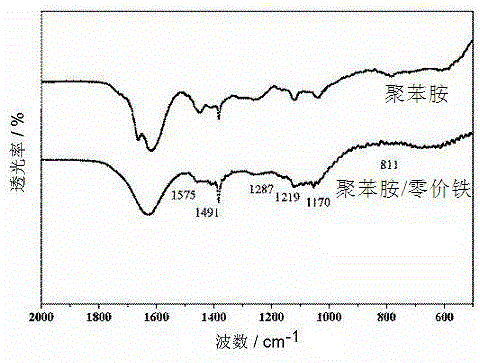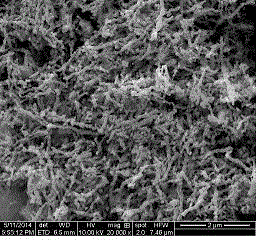Method for treating organic wastewater based on polyaniline loaded nanoscale zero-valent iron
A nano-zero-valent iron, organic wastewater technology, applied in water/sewage treatment, chemical instruments and methods, oxidized water/sewage treatment, etc. and other problems, to achieve the effect of promoting electron transfer, wide effective pH range, and no secondary pollution
- Summary
- Abstract
- Description
- Claims
- Application Information
AI Technical Summary
Problems solved by technology
Method used
Image
Examples
Embodiment 1
[0020] Prepare 5mL of rhodamine B dye wastewater with a concentration of 9.6mg / L, adjust the pH value to 6.5 with HCl or NaOH, and pass in air to make the molecular oxygen concentration in the water 3.0mg / L, add 20.0mg of zero-valent iron percent The content of 33.3% polyaniline-supported nano-zero-valent iron was used as a catalyst, and magnetic stirring was performed at room temperature. After 120 min, the degradation rate of rhodamine B was 83.4%.
[0021] Under the same experimental conditions, 6.7 mg of nano-zero-valent iron was added to 5 mL of rhodamine B dye wastewater as a catalyst, and the degradation rate of rhodamine B was 11.7% after 120 min of reaction.
Embodiment 2
[0023] Prepare 5mL of rhodamine B dye wastewater with a concentration of 30.0mg / L, adjust the pH value to 6.5 with HCl or NaOH, and pass in oxygen to make the molecular oxygen concentration in the water 8.0mg / L, add 20.0mg of zero-valent iron percent The content of 33.3% polyaniline-supported nano-zero-valent iron was used as a catalyst, and magnetic stirring was performed at room temperature. After 120 min, the degradation rate of Rhodamine B was 76.9%.
[0024] Under the same experimental conditions, 6.7 mg of nano-zero-valent iron was added to 5 mL of rhodamine B dye wastewater as a catalyst, and the degradation rate of rhodamine B was 8.1% after 120 min of reaction.
Embodiment 3
[0026] Prepare 5mL of 2-chlorobiphenyl wastewater with a concentration of 1.0mg / L, adjust the pH value to 2.0 with HCl or NaOH, and introduce air to make the molecular oxygen concentration in the water 3.0mg / L, add 50.0mg of zero-valent iron Nano-sized zero-valent iron supported by polyaniline with a content of 33.3% was used as a catalyst, and magnetically stirred at room temperature. After 120 min, the degradation rate of 2-chlorobiphenyl was 72.2%.
[0027] Under the same experimental conditions, 16.7 mg of nano-zero-valent iron was added to 5 mL of 2-chlorobiphenyl wastewater as a catalyst, and the degradation rate of 2-chlorobiphenyl was 7.6% after 120 minutes of reaction.
PUM
 Login to View More
Login to View More Abstract
Description
Claims
Application Information
 Login to View More
Login to View More - R&D
- Intellectual Property
- Life Sciences
- Materials
- Tech Scout
- Unparalleled Data Quality
- Higher Quality Content
- 60% Fewer Hallucinations
Browse by: Latest US Patents, China's latest patents, Technical Efficacy Thesaurus, Application Domain, Technology Topic, Popular Technical Reports.
© 2025 PatSnap. All rights reserved.Legal|Privacy policy|Modern Slavery Act Transparency Statement|Sitemap|About US| Contact US: help@patsnap.com



